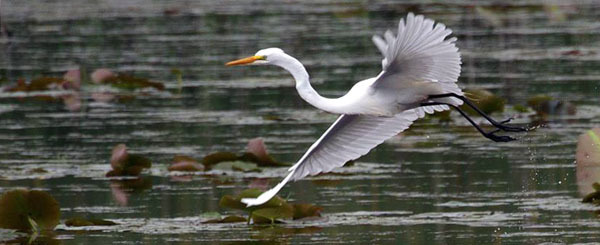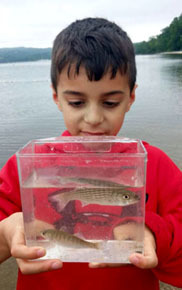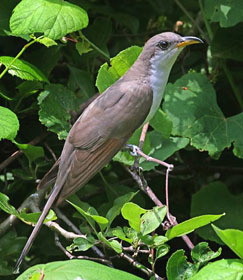Hudson River Almanac 6/17/17 - 6/23/17
The New York State Department of Environmental Conservation sent this bulletin on 06/30/2017 11:48 AM EDT |
| DEC Delivers - Information to keep you connected and informed from the NYS Department of Environmental Conservation |
| Share or view as a web page || Update preferences or unsubscribe |
|
|
HIGHLIGHT OF THE WEEK
[The Atlantic blue crab’s scientific name is Callinectes sapidus. Callinectes is from the Greek Callisto, meaning “most beautiful,” and nectes meaning “swimmer.” Its trivial name, sapidus, is from Latin meaning “savory.” It fully deserves deserve both the descriptive and culinary attributes. NATURAL HISTORY NOTES 6/17 – Town of Bethlehem, HRM 141: We launched our 24' cuddy cabin powerboat for its spring shakedown cruise this afternoon at Henry Hudson Park and headed upriver. We saw an outstanding variety of birds including a belted kingfisher, several bald eagles (one carrying a fish), and an osprey. The highlight, though, was a pair of very active peregrine falcons at the Collar City Bridge in Troy. It looked like there was a nest box on one of the piers that we had not noticed before. We also saw a peregrine at the Dunn Memorial Bridge zooming around while its partner was perched on the edge of a nest box. We even spotted a ruby-throated hummingbird flying across the river! The only adult eagle we saw was in a tree in the Moordener Kill, overlooking the river near its nest. 6/17 – Denning’s Point, HRM 60: The east-side bay where Fishkill Creek meets the Hudson River was almost completely covered with water chestnut (Trapa natans). A score of deadfalls were scattered along the green blanket and perched on them were a dozen or more double-crested cormorants. At least nine had struck their “Dracula” pose, wings outstretched, drying their feathers. They do this after spending time in the water because their wings lack the buoyant oils of most waterfowl.
[Some lab work, and corroboration by Bob Schmidt, revealed that approximately two-thirds of the haul were YOY Atlantic menhaden (Brevoortia tyrannus), a species of herring that spawn in salt to brackish water. The other third was YOY blueback herring. While not as odd as finding blueback herring in the East River (see June 3), it was still a surprise to find them this far downriver in mid-June. Tom Lake.] 6/18 – Westchester County: The more I drive up and down the Route 684-Hutchinson River Parkway corridor, the more new osprey nests I see. It seems that just about every cell tower has a nest on it. I counted at least four nests. It's great to see them so successful in such a heavily trafficked area.
6/19 – New Paltz, HRM 78: On my afternoon walk in the Mohonk Foothills, just before a string of afternoon thunderstorms rolled through the area, I saw my first monarch butterfly of the year. The lone monarch was dancing about the large expanses of foxglove beard-tongue (Penstemon digitalis). Sudden bursts of wind pushed it over the Lenape Lane fields, not allowing it to alight on any flowers. 6/19 – Croton-on-Hudson, HRM 35: After some huge downpours, Charlie Roberto found at least a dozen small (three-inch-long) Atlantic menhaden across a distance of 125 feet in his neighbor's yard. Although this was less than a mile from the river, where they are now found by the thousands, it would be difficult to make that connection. It was also hard to see where the downpours might have contributed. There were no overt signs of trauma, such as talon marks, leaving this find a real mystery. 6/19 – Manhattan, HRM 1: We checked our collection gear in midday at Pier 25 in Hudson River Park at The River Project’s sampling station on the lighthouse tender Lilac. In addition to a blue crab (135 mm carapace width), our crab pot had also collected two rather large blackfish/tautog (200-240 mm) and a winter flounder (210 mm). In one of our killifish traps we found a small oyster toadfish (50 mm). 6/20 – High Falls, HRM 87: I was hiking on the Ontario and Western (O&W) Rail Trail in midday when I noticed remnants of this year's snapping turtles' shells on the banks of a swamp. As I passed beneath the hollow of a tree, I looked up and saw a coiled black rat snake “unspooling’ itself upward. It must have been four feet long. It was beautifully camouflaged and seemed unearthly. Stepping back, I watched as it searched the bark and finally draped itself on a limb. 6/21 – Warren County, HRM 208: I made it up to Queensbury this evening in hopes of hearing the chuck-will's-widow that was first reported on May 28 on a West Mountain switchback off Northwest Mountain Road. The bird began singing just before dark and was still singing a half-hour later when I left. A whip-poor-will could be heard singing simultaneously with the chuck-will's-widow. This was a life-bird for me. [Long a bird of the southeastern coastal plain and lower Mississippi Valley, the chuck-will’s-widow (a relative of the whip-poor-will) has been expanding its range northward over the last 50 years. According to the Second Atlas of Breeding Birds in New York State, there were confirmed and probable nesting records on Long Island during field work for the 1980-1985 and 2000-2005 atlases. While habitat alteration has apparently reduced its numbers there, the species has been showing up more frequently in nearby states and now in upstate New York. Steve Stanne.] 6/21 – Kowawese, HRM 59: The water felt wonderful (79 degrees F) on the first day of summer, arguably the longest day of the year (the solstice arrived as we seined). We were searching for YOY river herring but found none. After several hauls, we did find yearling striped bass, small American eels, and many, many white perch. The dozen or more small blue crabs (35-55 mm carapace width) were a good sign for the late-summer-fall recreational crab season. A few more moults, and they would be of a market size (greater than five inches). In the wake of two days of rain (more than two inches) there was no measurable salinity. 6/21 – Croton Point, HRM 35-34: We had our Saw Mill River Audubon Summer Solstice walk tonight atop the Croton Point landfill grasslands. Our walk offered not only spotting scope viewing of three moons of Jupiter and the rings of Saturn, but interesting observations of three grassland birds singing at dusk: grasshopper sparrows, eastern meadowlark, and bobolinks. Five purple martins continued to visit and sing from the perches of their new martin nesting structure. 6/21– Bedford, RM 35: It was a sunny and warm day at the great blue heron rookery and the young herons were panting to cool off. As their wing feathers grow, they preen and exercise their wings. Their bills were growing longer and their body proportions maturing and they were beginning to look like smaller, but still darker, versions of their parents. No nest “guardians” were present today, and I saw two adults fly in to make a food drop while the rest of the nestlings patiently waited their turn to be fed. I have not seen any branching activity yet, but I expect that will occur soon. 6/21 – Manhattan, HRM 1: When we checked our sampling gear in early afternoon at Pier 25 in Hudson River Park at The River Project’s sampling station on the lighthouse tender Lilac, we found a familiar assemblage of fishes and crabs. In one crab pot, a blue crab (125 mm) tolerated the company of a white perch (190 mm) and a rather large tautog (240 mm). A killifish trap had collected a small oyster toadfish (40 mm). 6/22 – Esopus Meadows, HRM 87: It was dead low tide this evening at Esopus Meadows, prime hunting time for herons and eagles. Not surprisingly, we were treated to a fly-by of great blue herons as well as an immature bald eagle. 6/22 – Peekskill, HRM 43.5: While kayaking in Peekskill Bay today, I noticed that there was a pair of osprey back on the navigation tower. However, I could not see any activity in the nest. Later, while on a cruise aboard the Evening Star tour boat, the mate indicated that he had seen another head in the nest, suggesting at least one nestling. I also got to try an India Pale Ale made by a brewery in Poughkeepsie, in conjunction with Riverkeeper and the Evening Star. They had “conditioned” the beer by putting it in wooden casks and sailing it up the Hudson in an attempt to replicate the ocean voyages of the original IPAs. It was quite good. [The osprey nest on the light tower in Peekskill Bay was first noticed in 2013. If these are the same osprey, this would be their year five. Tom Lake.] 6/22 – Croton-on-Hudson, HRM 34.5: An osprey flew over the cell tower nest today at the Croton-Harmon train station and appeared to be attempting to land, hovering just above it while flapping it wings. After several seconds, the osprey flew over to one of the many light towers in the parking lot and landed. Shortly after that, a second osprey came flying over and aggressively chased the first one away. Perhaps it was a brazen juvenile or an unattached adult? 6/23 – Pine Plains, HRM 96: I spotted a great egret today at "The Fly," a wetland area just north of Pine Plains. According to Stan DeOrsey, Dutchess County Bird Historian, this was an early season record. The funniest thing I saw, however, was a brown thrasher on the ground chasing and pecking at a chipmunk. [See banner photo of great egret courtesy of Deborah Tracy-Kral.] [In addition to Deborah Tracy-Kral’s sighting, there have been only four other June records for Dutchess County since the 1970s. Tom Lake.] 6/23 – Wappinger Creek, HRM 67.5: The early morning low tide had turned to flood and the water chestnut beds were busy with four, widely-spaced great blue herons. One in particular caught the attention of an immature bald eagle that dropped down from a shoreline sycamore. The eagle made a pass, not really a stoop, but more of a wake-up call for the heron. The eagle turned and made another pass, this time coming much closer to the heron. The heron did a bob and weave but if the eagle was intent on getting the heron, it seemed like a less-than serious attempt. Then came a third pass, not more than a couple of feet above the heron. There were more bobs and weaves in an effort to be elusive, but the eagle simply spiraled up and went back to its perch in the sycamore. We concluded that these passes were “eagle games,” and the raptor was not really hungry. [Stooping is a term that is used by falconers and birders to describe a raptor’s dive. Webster’s Dictionary defines it as “to dive down swiftly; to attack prey.” Tom Lake.] SUMMER 2017 NATURAL HISTORY PROGRAMS Thursday, July 27: 7:00 PM HUDSON RIVER MILES The Hudson is measured north from Hudson River Mile 0 at the Battery at the southern tip of Manhattan. The George Washington Bridge is at HRM 12, the Tappan Zee 28, Bear Mountain 47, Beacon-Newburgh 62, Mid-Hudson 75, Kingston-Rhinecliff 95, Rip Van Winkle 114, and the Federal Dam at Troy, the head of tidewater, at 153. The tidal section of the Hudson constitutes a bit less than half the total distance – 315 miles – from Lake Tear of the Clouds to the Battery. Entries from points east and west in the watershed reference the corresponding river mile on the mainstem. TO CONTRIBUTE YOUR OBSERVATIONS OR TO SUBSCRIBE Smartphone app available for New York outdoor enthusiasts! Copies of past issues of the Hudson River Almanac, Volumes II-VIII, are available for purchase from the publisher, Purple Mountain Press, (800) 325-2665, or email purple@catskill.net |


 6/18 – Yonkers, HRM 18: The crew of the Groundwork Hudson Valley’s Science Barge pulled their “Medusa” eel mops out today for the last time. We had seven elvers but no glass eels. We have begun what we hope will be a summer-long study of the “beautiful swimmers,” the Atlantic blue crab. Last week we caught five; today our traps, baited with porgies or scup, collected 30, all males. The biggest was seven inches across its carapace (most averaged five to six inches). We also caught a baby oyster toadfish 50 millimeters [mm] long – fittingly in the oyster cage. To top the week off, a coyote was videotaped on a spit of land at the mouth of the Saw Mill River at its confluence with the Hudson. We speculated that it was eying the mallards and Canada geese. [Photo of blue crab courtesy of Gregg Kenney/DEC.]
6/18 – Yonkers, HRM 18: The crew of the Groundwork Hudson Valley’s Science Barge pulled their “Medusa” eel mops out today for the last time. We had seven elvers but no glass eels. We have begun what we hope will be a summer-long study of the “beautiful swimmers,” the Atlantic blue crab. Last week we caught five; today our traps, baited with porgies or scup, collected 30, all males. The biggest was seven inches across its carapace (most averaged five to six inches). We also caught a baby oyster toadfish 50 millimeters [mm] long – fittingly in the oyster cage. To top the week off, a coyote was videotaped on a spit of land at the mouth of the Saw Mill River at its confluence with the Hudson. We speculated that it was eying the mallards and Canada geese. [Photo of blue crab courtesy of Gregg Kenney/DEC.] 6/17 – Croton Point, HRM 35: We were moving our seining program along smartly for Clearwater’s thirty-ninth annual Great Hudson River Revival in an attempt to beat a promised early-afternoon thunderstorm (standing on an open beach holding six-foot-long poles at each end of a net is not the place to be when lightning is around). Our 120-foot-long seine had given us some expectations. However, until our final haul, we had only caught yearling striped bass (100-150 mm), a mix of adult and juvenile white perch, and feisty blue crabs. Allison Philpott had been watching large schools of small fish on the periphery of our net and, on our final haul, she suggested that we angle the seine into them. This was the “treasure haul,” as we found a thousand silvery young-of-the-year [YOY] herring (51-66 mm) in the bag of our net. At first glance they all appeared to be Atlantic menhaden, but quite a few of them had a little different look, so we collected some for later analysis. The water temperature was a warm 75.5 degrees Fahrenheit and the salinity was 2.5 parts-per-thousand [ppt]. [Photo of striped bass seined at Croton Point courtesy of Tom Lake.]
6/17 – Croton Point, HRM 35: We were moving our seining program along smartly for Clearwater’s thirty-ninth annual Great Hudson River Revival in an attempt to beat a promised early-afternoon thunderstorm (standing on an open beach holding six-foot-long poles at each end of a net is not the place to be when lightning is around). Our 120-foot-long seine had given us some expectations. However, until our final haul, we had only caught yearling striped bass (100-150 mm), a mix of adult and juvenile white perch, and feisty blue crabs. Allison Philpott had been watching large schools of small fish on the periphery of our net and, on our final haul, she suggested that we angle the seine into them. This was the “treasure haul,” as we found a thousand silvery young-of-the-year [YOY] herring (51-66 mm) in the bag of our net. At first glance they all appeared to be Atlantic menhaden, but quite a few of them had a little different look, so we collected some for later analysis. The water temperature was a warm 75.5 degrees Fahrenheit and the salinity was 2.5 parts-per-thousand [ppt]. [Photo of striped bass seined at Croton Point courtesy of Tom Lake.] 6/19 – Stanfordville, HRM 84: The cuckoos have been taking advantage of the tent and gypsy moth caterpillars this year. I have been hearing, but not seeing, at least two yellow-billed cuckoos, until today! [Photo of yellow-billed cuckoo courtesy of Deborah Tracy-Kral.]
6/19 – Stanfordville, HRM 84: The cuckoos have been taking advantage of the tent and gypsy moth caterpillars this year. I have been hearing, but not seeing, at least two yellow-billed cuckoos, until today! [Photo of yellow-billed cuckoo courtesy of Deborah Tracy-Kral.]